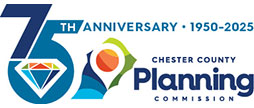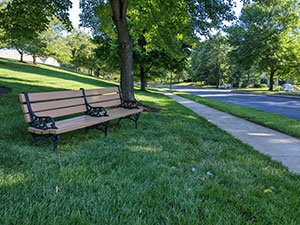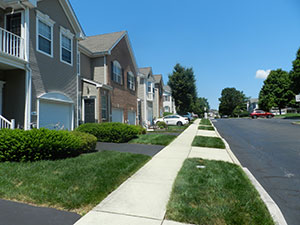Design Elements — Sidewalks
Sidewalks are a common amenity in conservation subdivisions and offer value to residents by creating a safe place to walk- whether to connect with amenities within and outside the development or just to take the dog for a walk. The need to provide sidewalks will depend on the size and density of the proposed subdivision. Where subdivision roads have very low traffic, the addition of sidewalks may be an unnecessary expense and add to the impervious surface. On busier roads or where the development is more suburban in nature, sidewalks should be provided and should connect to the open space trail system and any nearby destinations outside the development.
Ordinance Considerations
The sidewalk requirements provided in the Sample Ordinance Language section can be included in the General Design standards of the subdivision and land development ordinance. In addition, crosswalks should be required at all intersections where pedestrian circulation is existing, proposed, or is planned/desired in the future. In 2020 Chester County produced a county-wide inventory of all 73 Chester County municipalities' ordinances as they pertain to active transportation (trails, sidewalks, crosswalks, bike lanes, etc.) and prepared a report with planning guidance for encouraging these facilities. View a summary of findings.
Some municipal ordinances include language that leaves decisions about where sidewalks are required up to the discretion of the Board of Supervisors. CCPC recommends replacing discretionary language with concrete requirements when it comes to active transportation improvements like sidewalks. Discretionary language does provide flexibility to decide whether the proposed facilities are necessary on a site-specific basis, but it also can lead to inconsistency and network gaps over time as leadership and attitudes toward active transportation development may change. One way to target sidewalk requirements is to require developers to build active transportation infrastructure shown on an Official Map that coincides with the property to be developed (or redeveloped). Another way is to require sidewalks everywhere and make developers clearly demonstrate why the proposed facilities will NOT be feasible or necessary before granting a variance or waiver.
Sample Ordinance Language
- Sidewalks shall be provided on both sides of all streets in the following conditions:
- Within all commercial districts
- Within one thousand feet of any school, office building, medical institution, commercial use, shopping center, community facility, park, trail or other similar uses identified by the Board.
- Within all residential and mixed use subdivisions unless one of the conditions in subsection b or c below are met.
- Sidewalks may be required on only one side of the street in residential subdivisions for the following conditions:
- where residential lots are located on only one side of the street,
- where the overall density of the subdivision is low
- if the subdivision is located in a rural resource area as defined by Chester County's Landscapes Map that is anticipated to remain rural.
- Sidewalks may not be required within residential subdivisions in the following circumstances:
- If the development consists of large lots (2 acres or greater min.)
- In subdivisions of five or fewer proposed units.
- Sidewalks or pedestrian paths shall be required to connect residential areas with amenities within residential or mixed-use communities.
- Sidewalks shall have a minimum width of five feet .




